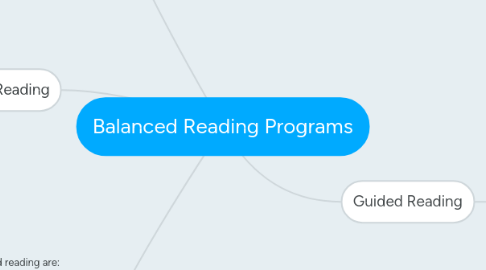
1. Shared Reading
1.1. The purposes of shared reading are:
1.1.1. To provide children with a positive experience about reading as well as teach students the reading process and increase their reading and writing profieciency. Texts can also be enjoyed by students who may not be able to read or access on their own
1.2. Teachers should look for texts at an appropriate level. Texts can be cross curricular, relevant and pique student's interest.
1.3. Students are gathered together for the lesson
1.4. Before reading: The teacher will ask the class to make predictions about the text, based on the cover, title and the rest of the book jacket
1.5. During Reading: teachers can model their predictions and engagement during the story. The teacher should be reading with proper inflection and tone in order for the students to continue to be engaged with the story
1.6. After Reading: Students to reflect on story based on their own experiences. Activities relating to the activity to follow
2. Read Aloud
2.1. Students are exposed to a wide range of stories and books
2.2. Children find and make connections to stories and their own personal lives
2.3. Use of comprehension strategies such as:
2.3.1. 1. Connect the book to their own life experience
2.3.2. 2. Connecting the book to other literature they have read
2.3.3. 3. Connecting what they are reading to universal concepts
2.4. Think alouds
2.4.1. Teacher to model inner conversations - poitning out similarities between books and connections to their own lives
3. Independent Reading
3.1. Student read materials on their own or with very little assistance. Can be in and out of the classroom
3.2. Students pick a book based on their level and interests. This is why it is important to have a classroom library that is well stocked and varied
3.3. Over time, children begin to discover different genres of books and grow to have an appreciation of reading
4. Guided Reading
4.1. Group students together based on levels
4.2. Teachers use mini-lessons and model questioning techniques with their students (small group reading instruction
4.2.1. Before Reading: Teacher will address the objectives of the lesson, make predictions, and use questioning to engage with the text before it is read
4.2.2. During Reading: Students read independently in the group, teacher to monitor. During this time, the teacher may ask scaffolding questions in order to assess students progress. The teacher makes observational notes and may keep a running record.
4.2.3. After Reading: The teacher will ask comprehension questions based on what the students have read. The teacher may use this opportunity to discuss reading strategies that the students found helpful to decode the text. Furthermore, the teacher should bring the lesson back to the objective, and state how the lesson has covered the objective
